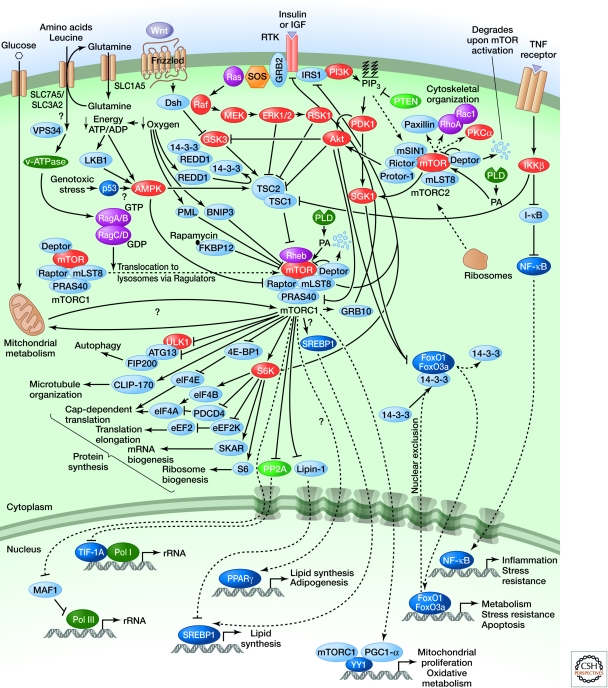Abstract
The mammalian target of rapamycin (mTOR) is a serine/threonine kinase that integrates environmental cues (e.g., growth factors and energy status) to control cell growth and proliferation.
The scarcity of nutrients/energy interspersed with sporadic periods of abundance means that cells must transition between anabolic and catabolic states. An important protein that has evolved to respond to this need is the target of rapamycin (TOR). TOR is a well-conserved serine/threonine kinase that plays an important role in the signaling network that controls growth and metabolism in response to environmental cues. As its name indicates, TOR is the target of a molecule named rapamycin, an anti-fungal macrolide produced by the bacterial species Streptomyces hygroscopicus, which was isolated from a soil sample from the Eastern Islands in the 1970s (Vezina et al. 1975). In addition to its anti-fungal properties, rapamycin strongly inhibits cell growth and proliferation, making this molecule a valuable tool to study cell growth control. In the early 1990s, yeast genetic screens led to the identification of TOR as one mediator of the toxic effect of rapamycin in yeast (Heitman et al. 1991; Kunz et al. 1993). Shortly after, the mammalian TOR (mTOR), now officially known as the mechanistic TOR, was identified as the physical target of rapamycin (Fig. 1) (Brown et al. 1994; Sabatini et al. 1994; Sabers et al. 1995).
Figure 1.
A simplified view of the mTOR pathway. (Adapted from Laplante and Sabatini 2009b.)
mTOR interacts with many proteins to form at least two distinct multiprotein complexes: mTOR complex 1 (mTORC1) and mTOR complex 2 (mTORC2) (Zoncu et al. 2011). In addition to their different protein compositions, the mTOR complexes have important differences in their sensitivities to rapamycin, in the upstream signals they integrate, in the substrates they regulate, and in the biological processes they control (Laplante and Sabatini 2009b). mTORC1 is sensitive to rapamycin and integrates inputs from at least five major signals—growth factors, genotoxic stress, energy status, oxygen, and amino acids—to regulate many processes involved in the promotion of cell growth and proliferation (Fig. 2). With the exception of amino acids, all of these inputs regulate mTORC1 activity by modulating the activity of TSC1–TSC2. TSC1–TSC2 negatively regulates mTORC1 activity by converting Rheb into its inactive GDP-bound state. Growth factors block TSC1–TSC2 activity and activate mTORC1, whereas genotoxic stress, energy deficit, and oxygen deprivation promote TSC1–TSC2 action and inhibit mTORC1. Conversely, amino acids activate mTORC1 through the action of the Rag GTPases. In the presence of amino acids, the Rag GTPases interact with mTORC1, which promotes its translocation from the cytoplasm to lysosomal membranes, where Rheb is thought to reside.
Figure 2.
The mTOR pathway.
When activated, mTORC1 promotes protein synthesis mainly by phosphorylating the kinase S6K and the translation regulator 4E-BP1 (Ma and Blenis 2009). This complex also induces lipid biogenesis by activating SREBP1 and PPARγ transcription factors (Laplante and Sabatini 2009a). In addition to promoting anabolism, mTORC1 also inhibits catabolism by blocking autophagy through the phosphorylation of the ULK1–Atg13–FIP200 complex. Importantly, sustained mTORC1 activation blocks growth factor signaling by activating many negative feedback loops that inhibit PI3-kinase (PI3K) signaling.
Compared with mTORC1, our knowledge of mTORC2 biology is still very limited. mTORC2 is activated by growth factors through a mechanism that is not well understood. It is insensitive to acute treatment with rapamycin and regulates cell survival, metabolism, and cytoskeletal organization by phosphorylating many AGC kinases, including Akt, SGK1, and PKCα (Laplante and Sabatini 2009b; Zoncu et al. 2011).
Acknowledgments
Figure 2 adapted from Laplante and Sabatini (2009b).
Footnotes
Editors: Lewis Cantley, Tony Hunter, Richard Sever, and Jeremy W. Thorner
Additional Perspectives on Signal Transduction available at www.cshperspectives.org
REFERENCES
- Brown EJ, Albers MW, Shin TB, Ichikawa K, Keith CT, Lane WS, Schreiber SL 1994. A mammalian protein targeted by G1-arresting rapamycin-receptor complex. Nature 369: 756–758 [DOI] [PubMed] [Google Scholar]
- Heitman J, Movva NR, Hall MN 1991. Targets for cell cycle arrest by the immunosuppressant rapamycin in yeast. Science 253: 905–909 [DOI] [PubMed] [Google Scholar]
- Kunz J, Henriquez R, Schneider U, Deuter-Reinhard M, Movva NR, Hall MN 1993. Target of rapamycin in yeast, TOR2, is an essential phosphatidylinositol kinase homolog required for G1 progression. Cell 73: 585–596 [DOI] [PubMed] [Google Scholar]
- Laplante M, Sabatini DM 2009a. An emerging role of mTOR in lipid biosynthesis. Curr Biol 19: R1046–R1052 [DOI] [PMC free article] [PubMed] [Google Scholar]
- Laplante M, Sabatini DM 2009b. mTOR signaling at a glance. J Cell Sci 122: 3589–3594 [DOI] [PMC free article] [PubMed] [Google Scholar]
- Ma XM, Blenis J 2009. Molecular mechanisms of mTOR-mediated translational control. Nat Rev Mol Cell Biol 10: 307–318 [DOI] [PubMed] [Google Scholar]
- Sabatini DM, Erdjument-Bromage H, Lui M, Tempst P, Snyder SH 1994. RAFT1: A mammalian protein that binds to FKBP12 in a rapamycin-dependent fashion and is homologous to yeast TORs. Cell 78: 35–43 [DOI] [PubMed] [Google Scholar]
- Sabers CJ, Martin MM, Brunn GJ, Williams JM, Dumont FJ, Wiederrecht G, Abraham RT 1995. Isolation of a protein target of the FKBP12–rapamycin complex in mammalian cells. J Biol Chem 270: 815–822 [DOI] [PubMed] [Google Scholar]
- Vezina C, Kudelski A, Sehgal SN 1975. Rapamycin (AY-22,989), a new antifungal antibiotic. I. Taxonomy of the producing streptomycete and isolation of the active principle. J Antibiot (Tokyo) 28: 721–726 [DOI] [PubMed] [Google Scholar]
- Zoncu R, Efeyan A, Sabatini DM 2011. mTOR: From growth signal integration to cancer, diabetes and ageing. Nat Rev Mol Cell Biol 12: 21–35 [DOI] [PMC free article] [PubMed] [Google Scholar]




